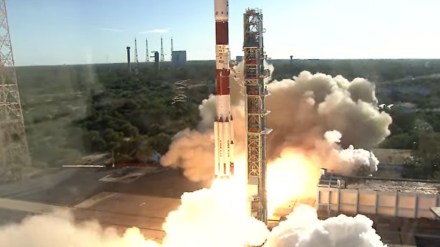The Indian Space Research Organisation (ISRO) marked another milestone in its space exploration journey by launching the PSLV-C59/PROBA-3 mission from the Satish Dhawan Space Centre, Sriharikota, Andhra Pradesh. The mission, a dedicated commercial undertaking of NewSpace India Limited (NSIL), aims to deploy the European Space Agency’s (ESA) Proba-3 spacecraft into a highly elliptical orbit.
“PSLV-C59 has successfully soared into the skies, marking the commencement of a global mission led by NSIL, with ISRO’s technical expertise, to deploy ESA’s groundbreaking PROBA-3 satellites. A proud moment celebrating the synergy of international collaboration and India’s space achievements,” stated ISRO on X.
Originally slated for launch at 4:08 PM on December 4, the mission was postponed briefly. At ESA’s request, ISRO delayed the lift-off to address an anomaly detected in the satellite propulsion system. After meticulous checks, the launch was rescheduled and successfully conducted on December 5 at 4:04 PM IST. ISRO confirmed the countdown and launch progress via real-time updates, emphasising the collaboration between NSIL and ISRO’s technical expertise.
What is Proba-3?
The Proba-3 mission, an ESA initiative funded through the General Support Technology Programme, is a technology demonstration project designed to study the Sun’s corona. The mission features two satellites: Coronagraph (310 kg) and Occulter (240 kg). These spacecraft will perform precise formation flying, maintaining a separation of just 150 millimetres, to achieve advanced solar observations.
The corona, the Sun’s outer atmosphere, is much hotter than the Sun’s surface and is the origin of space weather. Studying the corona is of significant scientific and practical interest, offering insights into solar phenomena and their impact on Earth.
Key Mission Details
- Rocket Configuration: The PSLV-C59 is a 44.5-meter-tall vehicle and part of the trusted PSLV-XL variant, designed for deploying heavier payloads. This launch marks the 61st flight of the PSLV and the 26th with the XL configuration.
- Orbit and Formation: The satellites will be placed in a 19-hour elliptical orbit, with a journey lasting 18 minutes post-lift-off. Once in position, the spacecraft will align 150 meters apart, with the Occulter blocking the Sun’s disk to enable the Coronagraph to observe the solar corona.
- Scientific Objective: Instruments onboard will observe the solar rim for up to six hours at a time, providing critical data for understanding space weather and advancing solar research.
Advancing ISRO’s Solar Exploration Goals
For ISRO, the mission extends its expertise in launching advanced scientific payloads and builds on its recent success with Aditya-L1, India’s maiden solar mission launched in September 2023. The PSLV-C59/PROBA-3 mission offers valuable experience and reinforces ISRO’s position as a key player in global space research.
The name “Proba,” derived from Latin meaning “Let’s try,” reflects the mission’s innovative approach. The two satellites will demonstrate unprecedented precision in formation flying, showcasing advancements in satellite technology and collaborative international space efforts.
With the successful launch of PSLV-C59/PROBA-3, ISRO has not only furthered its legacy of reliable space missions but also strengthened its partnership with global agencies like ESA. The mission promises significant contributions to solar research and reaffirms ISRO’s leadership in space exploration and scientific innovation.
